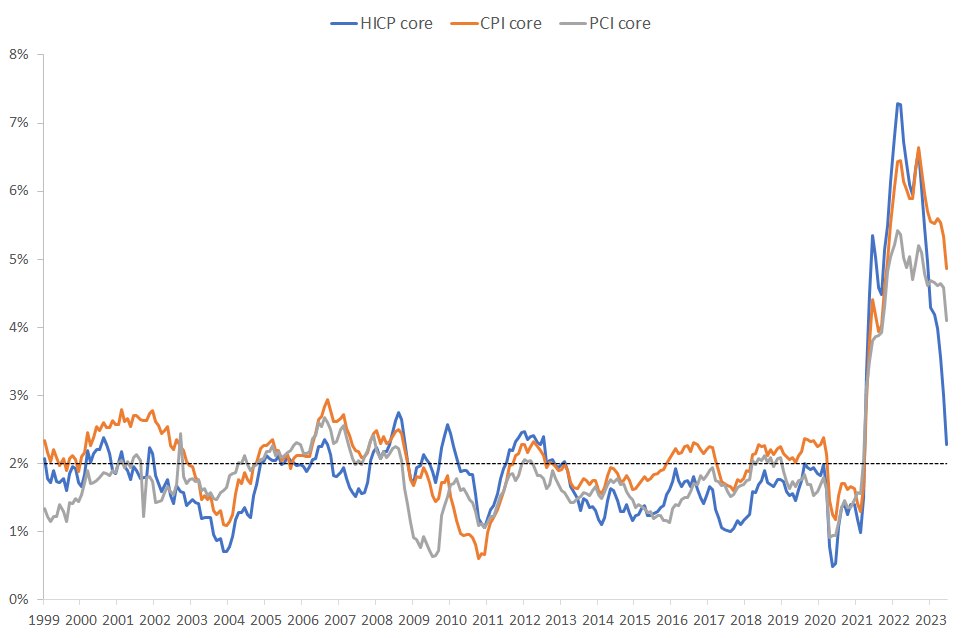(This post is an interlude between history and VARs)
Jesper Rangvid has a great blog post today on different inflation measures.
CPI and PCE core inflation (orange and gray) are how the US calculates inflation less food and energy, but including housing. We do an economically sophisticated measure that tries to measure the "cost of housing" by rents for those who rent, plus how much a homeowner pays by "renting" the house to him or herself. You can quickly come up with the plus and minus of that approach, especially for looking at month to month trends in inflation. Europe in the "HICP core" line doesn't even try and leaves owner occupied housing out altogether.
Jesper's point: if you measure inflation Europe's way, US inflation is already back to 2%. The Fed can hang out a "mission accomplished" banner. (Or, in my view, a "it went away before we really had to do anything serious about it" banner.) And, since he writes to a European audience, Europe has a long way to go.
A few deeper (and slightly grumpier) points:
Notice just here how different measures of inflation broadly correlated, but are 1-2% different from each other. Well, inflation is imprecisely measured. Get used to that and stop worrying too much about anything past the decimal point.
All this business about core vs. headline, hosing vs nonhousing, PCE vs. CPI, inflation is fine all except for three categories, and so forth is a bit confusing. In the end, inflation is inflation, and all goods matter. You pay for food, energy, and housing. So why ignore these? Why not use the most comprehensive measure always? The best number we have for the overall rise of the cost of living in the US is the full PCE, including all households, and food, energy, and housing. Inflation is not over and the mission not accomplished until it is over, and that includes food energy and housing. Why is it not just sophistry to say "well, inflation is back to 2% except for food energy and housing, so the fight is over?" "Every ship but your four fastest" is not "every ship."
The usual (implicit) argument is that core inflation is a better predictor of overall inflation a year from now than is today's full inflation. Food and energy prices have upward and downward spikes that predictably reverse themselves. The argument must be similar for leaving out imputed rents. There are predictable housing price dynamics in how house prices and rents feed into each other, and how rents on new leases propagate to rents of old ones when they roll over. That one might have some behavioral argument that households being both landlord and tenant don't feel the pain and don't adjust behavior as quickly in response to opportunity costs as renters do to out of pocket costs. But that should be reflected in what you do with the number rather than leaving it out of the data.
More generally, why do people indulge in this economist nerd pastime of slicing and dicing inflation to what went up and what went down and how might it be different if we left this or that out? Figuring out what it means for overall inflation in the future is the only reason I can see for it. (Perhaps figuring out whose inflation went up or down more than someone else's is also a reason to do it.)
But this ought to be a lot more rigorous. If the point is, we look at core today because core is a better forecast of inflation a year from now than inflation today, let's see the regression evidence. Is it true that
All goods and services inflation a year from now = a + b x Core inflation today + error
produces a better forecast than
All goods and services inflation a year from now = a + b x All goods and services inflation today + error?
That is not the exact regression you'd run, of course. I might start with
PCE (t+1) = a + b x PCE(t) + c x (Core(t)-PCE(t)) + error.
And we want to include other variables really. If the game is to forecast PCE a year from now, then you want an appropriate kitchen sink on the right hand side, up to overfitting. Just how important is core vs. pce in that kitchen sink? How much does looking at all the various components of inflation help to forecast inflation? Let's put those expiring lease dynamics in to forecast housing inflation, explicitly.
I suspect the answer is that all of this does not help much. My memory of Jim Stock and Mark Watson's work on forecasting inflation with lots of right hand variables is that it's really hard to forecast inflation. But that was 20 years ago.
So I'll leave this as a question for commenters. How can we best forecast inflation? How does looking at various components of inflation help you to forecast the overall quantity? This must be a question with a well established answer, no? Send your favorite papers in the comments. (If you can't get blogger's horrible comment system to work send email.)
If not, it's today's suggestion for low hanging fruit paper topic! How looking at components does or does not help to forecast overall inflation is a really important question.
A last comment: People look at all the various components of inflation, but don't ever (that I have seen) cite forecasting overall inflation as the explicit question. They quite often say that the component view suggests inflation is or isn't going to rise in the future, so I'm imputing this as the question. If not, what is the question? Why are we looking at components? In so many areas, it's interesting that people so seldom state the question to which they proffer answers.
from The Grumpy Economist https://ift.tt/DZxbkOh


0 comments:
Post a Comment